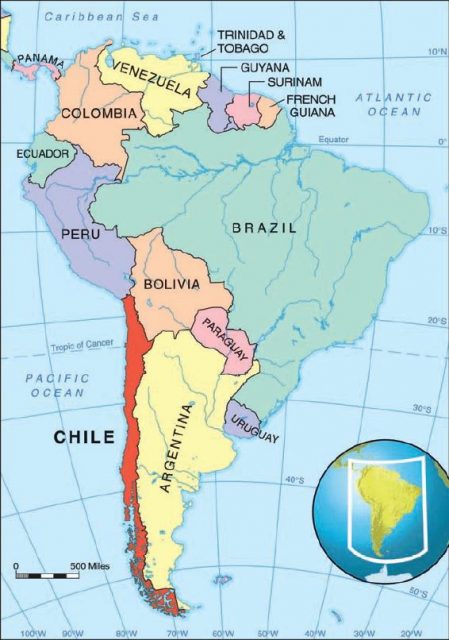Chile: Introduction
Chile has a little of everything. It is rich in copper, fruits, forests, and fish. It is a country of dramatic scenery and many climates. Cool waters stroke its shore and icy glaciers crown its peaks. Sighs of volcanoes and jolts of earthquakes shake its ribs. Squeezed between the heights of the mountains and the depths of the sea, Chile is a geologic marvel. Despite this physical diversity, a sense of nationhood among its people unifies the country.
Chile is situated on the extreme southwestern coast of South America. The Pacific Ocean lies to the west; Argentina and Bolivia are to the east. No country in the world has such an extraordinary shape as Chile. Its territory consists of a long, narrow ribbon of land that runs north to south for approximately 2,700 miles (4,400 kilometers). Its maximum width is barely 100 miles (160 kilometers). With an area of 292,260 square miles (756,950 square kilometers), Chile is a little smaller than Texas. The nation has the world's driest desert and some of the highest mountains. Approximately 70 percent of the land is mountainous, as the Andes Mountains extend the length of the country and form a natural barrier between Argentina and Bolivia.

Chile's name has no connection with the Spanish word “chili,” as in chili pepper, but the words are pronounced the same. Most scholars believe that the name Chile comes from a native Indian word—Tchilli, meaning “snow” or “cold.” The Indians lived in a valley not far from where the country's capital and largest city, Santiago, is today. They named the valley Tchilli because cold air and snow would blow into the lowland from Andean peaks. The similarity in the meaning of the native word Tchilli to the English word “chilly” is simply a coincidence.
This oddshaped country with a strange name is one of the world's most respected nations. Its history of political stability is unmatched in Latin America. Its economic genius helped ignite the global economy of the 1990s. It continues to have one of the fastest growing economies in South America. It is also an honest country, which for a developing nation is unusual. Taxes are actually collected, the police generally do not seek or take bribes, and most politicians are honest.
Chile's location south of the equator means that its seasons are the opposite of those of places like the United States and Europe. Summer officially begins on December 21 and ends on March 21. Winter begins on June 21 and continues until September 21. The reversal in the timing of the summer and winter seasons may not seem important at first. In some respects, however, life in Chile is upside down compared to ours. Chileans celebrate Christmas just like we do, only in the hottest time of the year. Imagine decorating a Christmas tree with tinsel and icicles in the heat of summer! On Christmas Day, Chileans can enjoy picnics at the beach or meals in the backyard. Pity the poor fathers who have to dress up in weighty Santa Claus costumes in the summertime, though.
Practically speaking, the opposite seasons help Chile's economy. In January, supermarkets in North America and Europe are selling fruit plucked fresh a few weeks earlier in Chile's Central Valley and Andean foothills. In addition, skiers in the United States and Europe come to Chile's Andean ski resorts from June to the middle of October to extend their ski season.
Other nations envy Chile's physical beauty, democratic tradition, economic success, and attractive culture. Described here is how geography and history converged to create the nation of Chile, as well as an outline of its future problems and prospects. This study begins by examining Chile's diverse physical landscapes, because the land is the stage on which a nation plays out its unique existence.